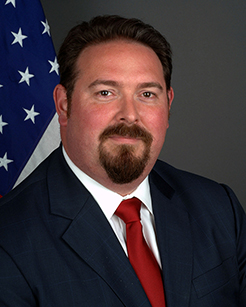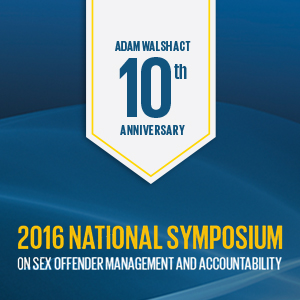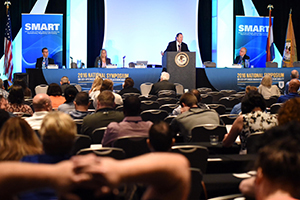Adam Walsh Child Protection and Safety Act of 2006
SMART FY 2021 Keep Young Athletes Safe
SMART FY 2020 Keep Young Athletes Safe Continuation
Recognizing a Decade of Progress at SMART
For the past 10 years, the Office of Sex Offender Sentencing, Monitoring, Apprehending, Registering, and Tracking (SMART) has been at the forefront of implementing effective practices to register and manage sex offenders.
This summer, we'll be recognizing the 10th anniversary of the Adam Walsh Child Protection and Safety Act of 2006. This legislation, named after the 6-year-old boy whose senseless murder led to increased public...
SMART Office Recognizes the 10th Anniversary of the Adam Walsh Act
It's been a decade since the passage of the Adam Walsh Child Protection and Safety Act of 2006, enacted in memory of the 6-year-old boy whose brutal murder brought national attention to the dangers posed by child predators and other violent offenders.
We've come a long way over those 10 years in meeting the complex challenges of sex offender management and building a...
What Do We Know About Sex Offenders?
What comes to mind when you hear the phrase "sex offender"? We know that sex offenders, like the general criminal population, are not a monolithic group. Some sex offenders are pedophiles, some act out in response to their own abuse and some commit these crimes as part of an overall criminal lifestyle. While some may reoffend regardless of criminal justice intervention, some respond well to...
SMART Forges Partnerships to Manage Sex Offenders
On July 27, 1981, 6-year-old Adam Walsh entered a Florida department store with his mother. He was abducted by a stranger, and his remains were found two weeks later. The tragedy of the young boy's murder—a brutal crime that was never brought to trial—shocked the nation. His devastated family and supporters channeled their grief and anger in a positive way―to protect other children from sexual...
SORNA Substantial Implementation Update
The SMART Office has received and reviewed a tremendous amount of information and material from the States, territories, and the District of Columbia about their progress toward substantial implementation of the Sex Offender Registration and Notification Act (SORNA), 42 U.S.C. § 16925(a) (Title I of the Adam Walsh Child Protection and Safety Act of 2006). To date, the SMART Office has received and reviewed full...
SORNA: Tribal Election, Delegation to the State and Right of Access
Title I of the Adam Walsh Child Protection and Safety Act of 2006, the Sex Offender Registration and Notification Act (SORNA), created the first opportunity for federally recognized Indian tribes to be included in a nationwide sex offender registration and notification system. SORNA specifies, with some restrictions, that a federally recognized Indian tribe may, by resolution or other enactment of the tribal council or comparable...
SORNA: Clarification of Registration Jurisdictional Issues
Title I of the Adam Walsh Child Protection and Safety Act of 2006, the Sex Offender Registration and Notification Act (SORNA), requires that sex offenders register in any jurisdiction where they live, work or go to school (see 34 U.S.C. § 20913 (a)).
There are a number of Indian tribes that are SORNA registration jurisdictions and, in some instances, the geographical apportionment of tribal lands...
SORNA: State and Tribal Information Sharing
Title I of the Adam Walsh Child Protection and Safety Act of 2006, the Sex Offender Registration and Notification Act (SORNA), requires that jurisdictions share information within their jurisdictions as well as with other registration jurisdictions (see 34 U.S.C. § 20913 (c) and 34 U.S.C. § 20923 (b) (3)). Because of the unique nature of criminal justice coordination between states and tribes, collaboration is encouraged...
Registering Tribal Convictions under SORNA
Title I of the Adam Walsh Child Protection and Safety Act of 2006, the Sex Offender Registration and Notification Act (SORNA), requires registration for anyone convicted of a sex offense, which is defined as "a criminal offense that has an element involving a sexual act or sexual contact with another ... " (see 34 U.S.C. § 20911(5)). Under SORNA, a "criminal offense" is defined as...
SORNA: Fingerprints and Palm Prints
Title I of the Adam Walsh Child Protection and Safety Act of 2006, the Sex Offender Registration and Notification Act (SORNA), requires that jurisdictions include in their registries a set of fingerprints and palm prints from each sex offender (see 34 U.S.C. § 20914(b)(5)). The National Guidelines for Sex Offender Registration and Notification specify that jurisdictions must maintain fingerprints and palm prints in digital format...
Military Convictions Under SORNA
Title I of the Adam Walsh Child Protection and Safety Act of 2006, the Sex Offender Registration and Notification Act (SORNA), specifically includes certain Uniform Code of Military Justice (UCMJ) convictions in its definition of "sex offense."
Department of Defense Instruction 1325.07 contains the specific list of UCMJ convictions that require registration under SORNA.1 Jurisdictions must ensure that all of the UCMJ convictions listed...
SORNA: Text of Registration Offense
Title I of the Adam Walsh Child Protection and Safety Act of 2006, the Sex Offender Registration and Notification Act (SORNA), requires that each jurisdiction's registry include "[t]he text of the provision of law defining a criminal offense for which the sex offender is registered" (see 34 U.S.C. § 20914 (b)(2)). The National Guidelines on Sex Offender Registration and Notification have since clarified this requirement...
SORNA: Determination of Residence, Homeless Offenders and Transient Workers
Title I of the Adam Walsh Child Protection and Safety Act of 2006, the Sex Offender Registration and Notification Act (SORNA), requires that jurisdictions must register homeless and transient sex offenders, as well as offenders without fixed employment locations. The National Guidelines for Sex Offender Registration and Notification advise that, for the purposes of registration under SORNA, a sex offender resides in a jurisdiction when...
Using Risk Assessment Under SORNA
Title I of the Adam Walsh Child Protection and Safety Act of 2006, the Sex Offender Registration and Notification Act (SORNA), requires a conviction-based structure for sex offenders' registration and notification requirements. SORNA does not address the use of risk assessment tools for registration or notification purposes. Many jurisdictions currently use risk assessment processes for a variety of purposes. These include aiding in making release...
Community Notification Requirements of SORNA
Title I of the Adam Walsh Child Protection and Safety Act of 2006, the Sex Offender Registration and Notification Act (SORNA), requires that registration jurisdictions immediately provide any initial or updated information about a sex offender to entities that fall under specific categories (see 34 U.S.C. §20923(b)). Each category is addressed in turn below, with direction on how jurisdictions can substantially implement its terms...
SORNA In Person Registration Requirements
Title I of the Adam Walsh Child Protection and Safety Act of 2006, the Sex Offender Registration and Notification Act (SORNA), requires that a registered sex offender appear in person regularly to update certain registration information according to the following criteria (see 34 U.S.C. § 20918):
- Tier I offenders must appear once per year for 15 years
- Tier II offenders must appear every six...
Byrne JAG Grant Reductions Under SORNA
34 U.S.C. § 20927(a) sets forth a penalty for jurisdictions that fail to substantially implement Title I of the Adam Walsh Child Protection and Safety Act of 2006, the Sex Offender Registration and Notification Act (SORNA):
For any fiscal year after the end of the period for implementation, a jurisdiction that fails, as determined by the Attorney General, to substantially implement this title shall not...
Reallocation of Byrne JAG Funding
The Adam Walsh Child Protection and Safety Act of 2006 (AWA) established a penalty for jurisdictions that failed to substantially implement the Sex Offender Registration and Notification Act (SORNA) by July 27, 2011, and for any year thereafter. The AWA further provided that funding penalty amounts shall be reallocated to eligible jurisdictions that have substantially implemented SORNA or may be reallocated to a jurisdiction from...
Guidelines
The final guidelines for Title I of the Adam Walsh Child Protection and Safety Act of 2006, the Sex Offender Registration and Notification Act (SORNA) were published in the Federal Register on July 2, 2008.
- The National Guidelines for Sex Offender Registration and Notification - Final Guidelines, July 2008
- Supplemental Guidelines for Registration and Notification, January 11, 2011
- Federal...






